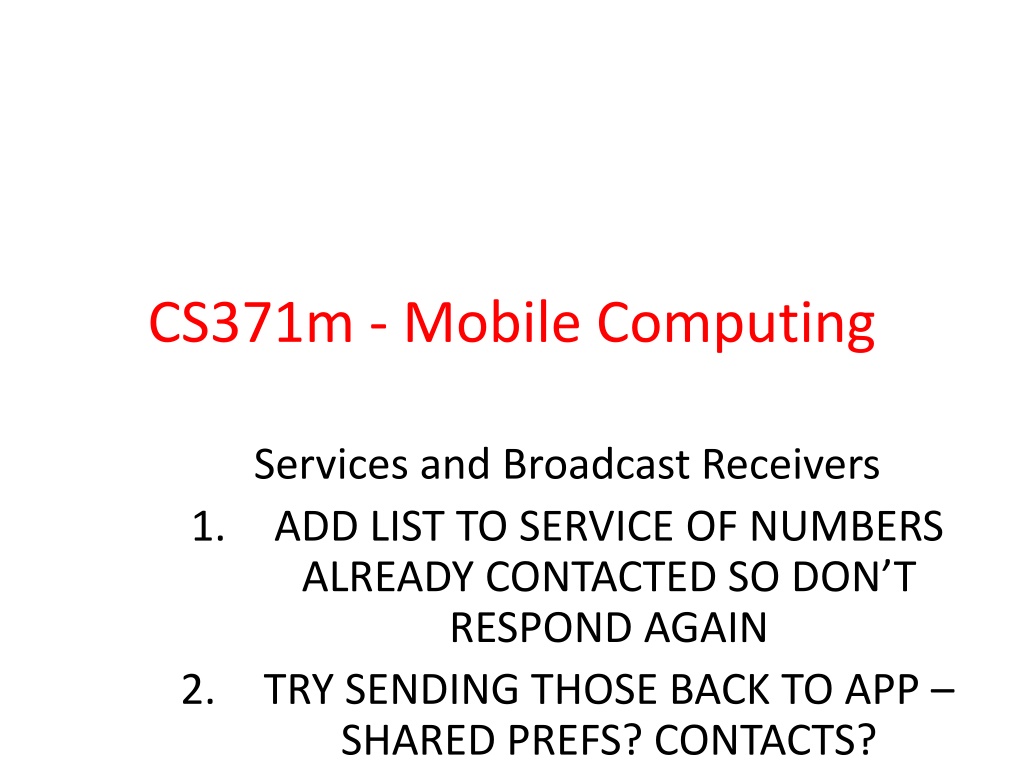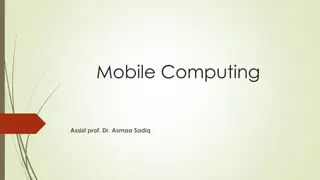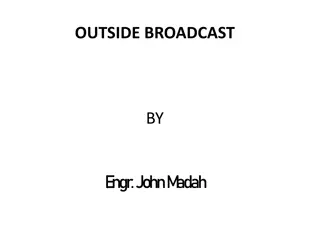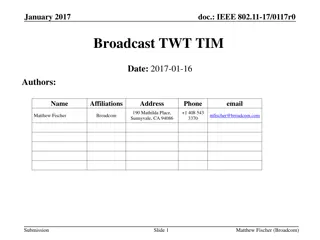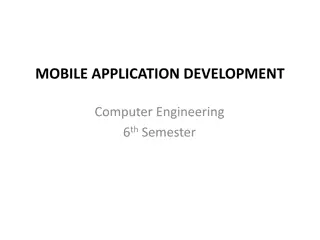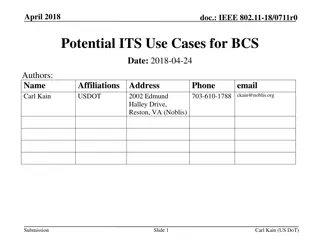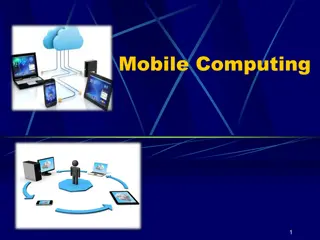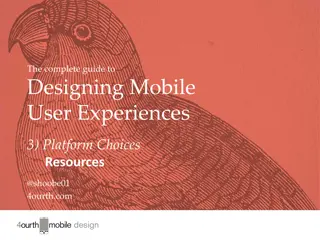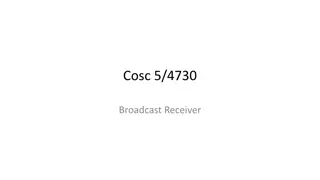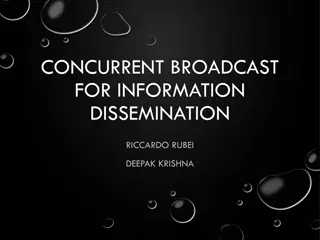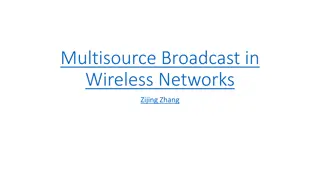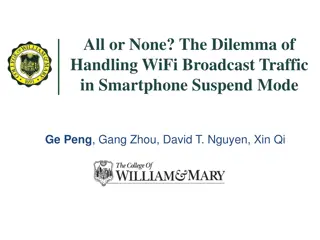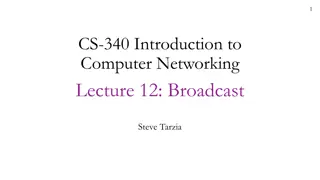Understanding Mobile Computing Services and Broadcast Receivers
Mobile computing services play a vital role in background operations of apps, allowing them to perform tasks even when not in use. Broadcast receivers help in efficient communication between components. Learn about key concepts and examples of services, how they are declared in the app manifest, and ways to start them.
Download Presentation

Please find below an Image/Link to download the presentation.
The content on the website is provided AS IS for your information and personal use only. It may not be sold, licensed, or shared on other websites without obtaining consent from the author. Download presentation by click this link. If you encounter any issues during the download, it is possible that the publisher has removed the file from their server.
E N D
Presentation Transcript
CS371m - Mobile Computing Services and Broadcast Receivers ADD LIST TO SERVICE OF NUMBERS ALREADY CONTACTED SO DON T RESPOND AGAIN TRY SENDING THOSE BACK TO APP SHARED PREFS? CONTACTS? 1. 2.
Clicker Is it possible for your app to accomplish work when the forefront Activity is not one from your app? A. Yes B. No 2
Services One of the four primary application components: activities content providers services broadcast receivers 3
Services - Purpose Application component that performs long-running operations in background with no UI application starts service and service continues to run even if original application ended or user moves to another application a way to run code when one of app's activity is not the forefront activity 4
Service - Examples Download app from store leave store app, but download continues any kind of download of upload via network Play music even when music player dismissed (if user desires) maintain connection in chat app when phone call received periodically poll website for updates / changes the grade checker may lead to notification 5
Clicker Will a class in your app that extends the Service class have an xml layout file? A. Yes B. No 6
Clicker Do services need to be declared in the app manifest file like activities? A. Yes B. No 7
Service Basics No User Interface Components Belongs to an app must be declared in the app manifest May be running even if app is not at forefront, interacting with the user May be private (usable only by the app they belong to) or public (usable by apps other than yours) 8
Starting Services Two ways to start services: 1. Manually by an app using a call to the API - recall the startActivity method for Activities 2. Another activity tries to connect (bind) to a service via inter process communication - may be an app other than yours if your make your service public 9
Stopping Services Services will run until shut down: 1. by themselves when task completed or possibly by owning app stopSelf 2. By the owning app via a call to stopService 3. If Android needs the RAM the service is using - just like it does for activities deep in the activity stack 10
Types Services - Started or Bound Started: application component, such as an Activity, starts the service with the method call startService() once started service can run in background indefinitely clean up after yourself generally services do not return a result (see bound service) can send a local broadcast when done if necessary to notify Activity or other Service service should stop itself when done Most services in our projects are started 11
Forms of Services - Started or Bound Bound application component binds itself to existing service via the bindService() method bound service provides client-server interface that allows application component to interact with service interact with service, send requests, get result via IPC (inter process communication) service runs as long as one or more applications bound to it destroyed when no applications bound 12
Forms of Services Service can be started and later bound to other applications so, both started and bound private service (manifest) cannot be bound by other applications 13
Communicating with Services Two ways: Commands no lasting connection to service example: start service, end service Binding creates communication channel between the service and other component other component typically an activity or perhaps another service 14
Service or Thread Past examples, kept UI thread responsive with other threads of execution, especially AsyncTask Should services be used for this? Service for actions that need to take place even if user not interacting with UI or has closed application Example, do complex rendering of image to display to user. Not a job for a service 15
Service Setup Must declare Services in manifest just like activities otherwise when Service started, app will crash No intent filter for Service makes it private. 16
Creating a Service Class create subclass of Android Service class or one of its existing subclasses commonly IntentService override callback methods that handle important aspects of service lifecycle most important of these are: onStartCommand onBind (bound services) onCreate onDestroy stopSelf 17
Service Lifecycle If component starts service with startService method (leads to call to onStartCommand) service runs until it calls stopSelf or another activity calls stopService if component calls bindService (onStartCommand not called) service runs as long as at least one component bound to it 18
Service Responsiveness Services run on the main thread of hosting process By default a Service does not create a separate thread of execution If plan to do intensive CPU ops or blocking ops within Service, must still create a separate thread of execution to avoid ANRs IntentService (subclass of Service) uses a worker thread to handle start requests 20
APP EXAMPLE THAT USES A SERVICE 21
Service App Example From Roger Wallace Spring 2011 wanted an app that would respond to texts (SMS) received when driving and respond with a message ("Driving - Get back to you soon.") Initial version simply auto responds to all texts how to change it so it responds only when driving? 22
Interesting Sidetrack - Disallowed? Google Play Developer Policy 23
Example Service Application From The Android Developer's Cookbook SMSResponder Application Response stored in shared preferences App allows changes to message, start auto SMS responses and stop auto SMS respones 24
Using SMS Permission in manifest file to send and / or receive SMS messages 25
SMSResponder Basic App onCreate set up layout 26
Check if Service Already Running Alternative: Use public, static variable or method in Service class to indicate if running or not. 30
Service Running Service is running 31
Simulating Texts Calls and texts can be simulated between emulators Start two emulators Use messaging app to send text Phone number is simply the emulator port number (visible at top of the emulator or in eclipse) 32
Creating a Service Extend the Service class adapter class exists, IntentService handles a lot of the details override onStartCommand return an int describing what system should do for starting service START_NOT_STICKY, if system kills service don't restart START_STICKY, if system kills service then recreate, but does not redeliver intent START_REDELIVER_INTENT, if system kills service then recreate and redeliver last intent 36
SMSResponser 37
Broadcast Receivers The third of four application components activities, services, broadcast receivers, content providers / receivers "A broadcast receiver is a component that responds to system-wide broadcast announcements." Android system sends multiple kinds of broadcasts screen turned off, battery low, picture captured, SMS received, SMS sent, and more 41
Broadcasts Another use of intents Intents used to start activities and services startActivity() startActivityForResult() startService() bindService() Also used to deliver information from system and applications to other applications via Broadcast Intents 42
BroadcastReceivers What broadcasts are available? Check the Intent class http://developer.android.com/reference/and roid/content/Intent.html search for "Broadcast Action" Also look in android-sdk\platforms\<number>\data\ broadcast_actions.txt 43
Clicker Can you app send out any Broadcasts it wants? A. yes B. no 45
Broadcasts from broadcast_ actions.txt in sdk files platforms-> <api level>-> data\ 46
Broadcast Intents You can create your own Broadcasts Intents Many Intents listed in the Intent class are protected intents that may only be send by the system 47
Protected Broadcasts Try it anyway?? 03-23 13:16:50.222 388-397/? W/ActivityManager: Permission Denial: not allowed to send broadcast android.intent.action.TIMEZONE_CHA NGED from pid=3470, uid=10140 48
Permissions Again Recall ... Android 6.0, Marshmallow, API level 23 introduced changes to permissions Dangerous vs. Normal permissions Necessary to request Dangerous Permissions at runtime, not install time Listening for SMS send and receive Broadcasts is a Dangerous Permission 49
Receiving Broadcasts Activities and Services can listen for Broadcasts 4 steps 1. subclass BroadcastRecevier ( implement onReceive method) 2. create IntentFilter object to specify the kinds of Broadcasts you want 3. register receiver (onResume() of Activity) 4. unregister receiver (onPause() of Activity) -- alternatively use manifest to register receiver 50
